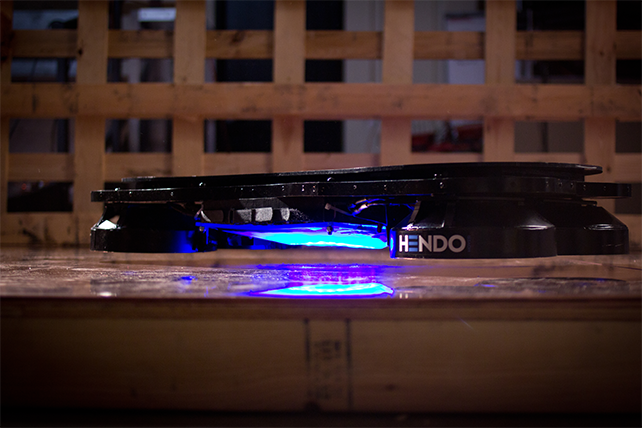Hours after police slammed him to the ground for trying to ride a "hoverboard" through security at Los Angeles International Airport, the rapper Wiz Khalifa took to Twitter to share some nuanced thoughts about his transportation gizmo of choice.
"All because I didn't want to ditch the technogy everyone will be using in the next 6 months," he said, of the confrontation. "I stand for our generation and our generation is gonna be riding hover boards so if you don't like it eat a dick!"
Well, that's certainly one way to put it.
Though Khalifa's proclamation likely killed his chances for a hoverboard industry spokesperson role, his scuffle with law enforcement may have turned him into the poster boy for the new motion movement sweeping the nation. Though not yet mainstream, so-called hoverboards, and other motorized walking-replacement devices, are growing in popularity, showing up everywhere from city sidewalks, to NBA locker-rooms, to YouTube and Vine videos shot by social media stars.
Unlike the Segways that may have paved the way for them, hoverboards are actually cool. They're being used by the right people, and seem to have little stigma attached. So prepare for them to stick around.
Here's a quick crash course on the devices driving this developing phenomenon.
Exhibit 1: The Hoverboard (less cool name: hands-free Segway)
A nonscientific study of motorized device popularity puts the two-wheeled hoverboard, aka the hands-free Segway, at the top of the pile. The device is the type Khalifa rode through the airport at the time of his kerfuffle. It was also put on display during the NBA finals by the Cleveland Cavaliers J.R. Smith, who rode it through the bowels of Cleveland's Quicken Loans Arena before and after games.
These hoverboards are pretty simple to use: You lean forward to go forward, lean backward to go in reverse, place a bit more pressure with your right foot to turn right, and place a bit more pressure with your left foot to turn left. (I tried one last week and almost flew through a window in a New York City office building — but I feel like I could get the hang of it within a week.)
The biggest name in the hoverboard category is the IO Hawk, which sells for about $1,200 on Amazon and has a max speed of 6.2 miles per hour, according to Amazon. There are cheaper models on the market though. In about five minutes of cursory Amazon research, I found one listed at $316.
Exhibit 2: The Motorized Skateboard
The motorized skateboard — yes, a skateboard with a motor (or two) on it — may be the most beloved of the bunch. (Please note: We're defining hoverboard loosely as a board that moves without you propelling it manually.) The Amazon page for the Boosted Dual+ 2000W Electric Skateboard, one popular model, is filled with loving testimonials and nary a sub-four-star review. "If my house caught fire it would definitely be one of the things I'd grab on the way out the door," Kacy Knight, one Amazon user, wrote in a review titled "This thing is a beast."
The Boosted board is propelled via a remote you hold in your hand while riding it. The remote allows you to accelerate or decelerate and you do the rest by leaning. You know, normal skateboard behavior. The board makes frequent cameos in Casey Neistat's YouTube vlog, which often features Neistat riding it through New York City traffic at high speeds, or wondering what's happened to strangers he's allowed take it for a spin. There are a handful of other motorized skateboards as well, but the Boosted boards appears to gliding away from the field.
OK, money. The Boosted costs lots of it. The high-end model on boostedboards.com goes for $1,499. The cheapest we saw was $999. On Amazon, you can find some motorized skateboards for under $200 though. Oh, and speed. The Boosted board is FAST. The high-end model reaches a top speed of 22 mph. So don't fall off. And wear a helmet for goodness' sake.
Exhibit 3: The WalkCar
The WalkCar isn't yet in production but it's impossible not to include here. A promotional video for the laptop-size hoverboard was unveiled by the Japanese company Cocoa Motors last month and made more than a few jaws drop. The company expects to make it available by spring 2016.
The WalkCar, according to Reuters, can go 6.2 miles per hour. It moves when you step on it. It turns when you shift your weight. Cocoa Motors told Reuters it plans to make the devices available for reservation via Kickstarter by this fall. It expects them to cost around $800.
As with all still-in-development products, it's worth approaching this one with caution. Still, here's the full Cocoa Motors video so you can see the thing in action:
Exhibit 4: The OneWheel
The OneWheel is the hoverboard with the most mystique. It is simply a board with a huge motorized wheel in the middle. It's the equivalent of that cool 4x4 your friend's older brother had while you watched from a distance with training wheels on your bike. It is badass, seemingly physics-defying, and, again, has only one wheel.
The way you ride the OneWheel — besides with great courage and purpose — is by standing upon the footrests on either side and leaning forward. Also: you must believe in yourself.
The OneWheel sells for $1,499 on rideonewheel.com. It reaches a top speed of 15 mph. It goes six to eight miles on its battery and charges fully in just 20 minutes. When I searched for equivalents on Amazon, the website punched me in the face.
Exhibit 5: The Lexus Hoverboard

This is the only hoverboard of the bunch that actually hovers. But it can only hover on a specifically designed track. And it's not being mass produced. And it was mostly created for a car commercial.
The Lexus hoverboard merits no further ink.
Exhibit 6: The Hendo Hoverboard

There's another hovering hoverboard called the Hendo Hoverboard, but it also can hover over only limited surfaces and its battery dies fairly quickly. The Hendo uses powerful magnets to remove itself from the ground, but that means it's mostly limited operating above metal sheets. Meh.
The Hendo team sold 11 hoverboards for $10,000 during a Kickstarter campaign, which it said it will deliver this October. Here's a video Hendo made to anchor that now-completed campaign:



